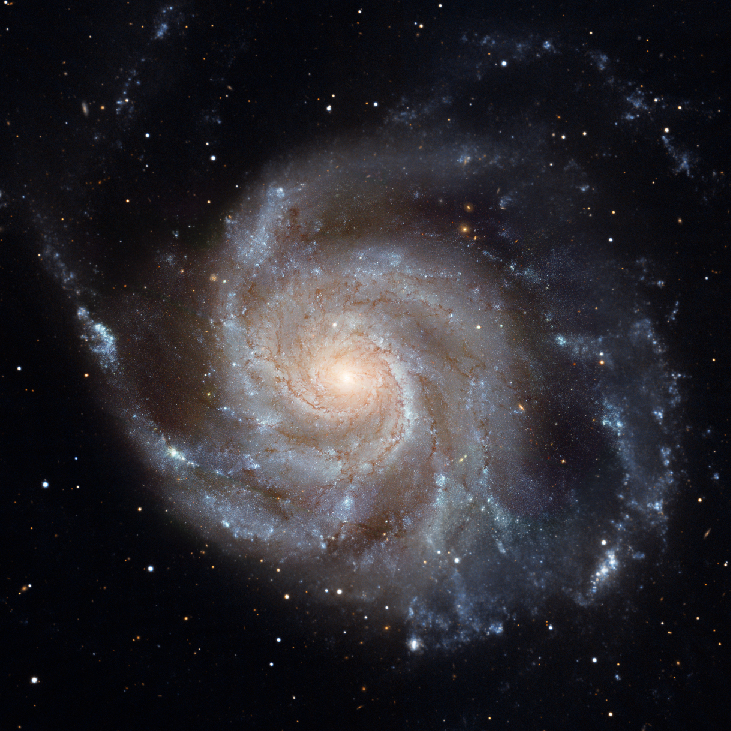| << Chapter < Page | Chapter >> Page > |
[link] summarizes the range of masses (and other properties) of the various types of galaxies. Interestingly enough, the most and least massive galaxies are ellipticals. On average, irregular galaxies have less mass than spirals.
| Characteristics of the Different Types of Galaxies | |||
|---|---|---|---|
| Characteristic | Spirals | Ellipticals | Irregulars |
| Mass ( M Sun ) | 10 9 to 10 12 | 10 5 to 10 13 | 10 8 to 10 11 |
| Diameter (thousands of light-years) | 15 to 150 | 3 to>700 | 3 to 30 |
| Luminosity ( L Sun ) | 10 8 to 10 11 | 10 6 to 10 11 | 10 7 to 2 × 10 9 |
| Populations of stars | Old and young | Old | Old and young |
| Interstellar matter | Gas and dust | Almost no dust; little gas | Much gas; some have little dust, some much dust |
| Mass-to-light ratio in the visible part | 2 to 10 | 10 to 20 | 1 to 10 |
| Mass-to-light ratio for total galaxy | 100 | 100 | ? |
A useful way of characterizing a galaxy is by noting the ratio of its mass (in units of the Sun’s mass) to its light output (in units of the Sun’s luminosity). This single number tells us roughly what kind of stars make up most of the luminous population of the galaxy, and it also tells us whether a lot of dark matter is present. For stars like the Sun, the mass-to-light ratio is 1 by our definition.
Galaxies are not, of course, composed entirely of stars that are identical to the Sun. The overwhelming majority of stars are less massive and less luminous than the Sun, and usually these stars contribute most of the mass of a system without accounting for very much light. The mass-to-light ratio for low-mass stars is greater than 1 (you can verify this using the data in [link] ). Therefore, a galaxy’s mass-to-light ratio is also generally greater than 1, with the exact value depending on the ratio of high-mass stars to low-mass stars.
Galaxies in which star formation is still occurring have many massive stars, and their mass-to-light ratios are usually in the range of 1 to 10. Galaxies consisting mostly of an older stellar population, such as ellipticals, in which the massive stars have already completed their evolution and have ceased to shine, have mass-to-light ratios of 10 to 20.
But these figures refer only to the inner, conspicuous parts of galaxies ( [link] ). In The Milky Way Galaxy and above, we discussed the evidence for dark matter in the outer regions of our own Galaxy, extending much farther from the galactic center than do the bright stars and gas. Recent measurements of the rotation speeds of the outer parts of nearby galaxies, such as the Andromeda galaxy we discussed earlier, suggest that they too have extended distributions of dark matter around the visible disk of stars and dust. This largely invisible matter adds to the mass of the galaxy while contributing nothing to its luminosity, thus increasing the mass-to-light ratio. If dark invisible matter is present in a galaxy, its mass-to-light ratio can be as high as 100. The two different mass-to-light ratios measured for various types of galaxies are given in [link] .

These measurements of other galaxies support the conclusion already reached from studies of the rotation of our own Galaxy—namely, that most of the material in the universe cannot at present be observed directly in any part of the electromagnetic spectrum. An understanding of the properties and distribution of this invisible matter is crucial to our understanding of galaxies. It’s becoming clearer and clearer that, through the gravitational force it exerts, dark matter plays a dominant role in galaxy formation and early evolution. There is an interesting parallel here between our time and the time during which Edwin Hubble was receiving his training in astronomy. By 1920, many scientists were aware that astronomy stood on the brink of important breakthroughs—if only the nature and behavior of the nebulae could be settled with better observations. In the same way, many astronomers today feel we may be closing in on a far more sophisticated understanding of the large-scale structure of the universe—if only we can learn more about the nature and properties of dark matter. If you follow astronomy articles in the news (as we hope you will), you should be hearing more about dark matter in the years to come.
The masses of spiral galaxies are determined from measurements of their rates of rotation. The masses of elliptical galaxies are estimated from analyses of the motions of the stars within them. Galaxies can be characterized by their mass-to-light ratios. The luminous parts of galaxies with active star formation typically have mass-to-light ratios in the range of 1 to 10; the luminous parts of elliptical galaxies, which contain only old stars, typically have mass-to-light ratios of 10 to 20. The mass-to-light ratios of whole galaxies, including their outer regions, are as high as 100, indicating the presence of a great deal of dark matter.

Notification Switch
Would you like to follow the 'Astronomy' conversation and receive update notifications?